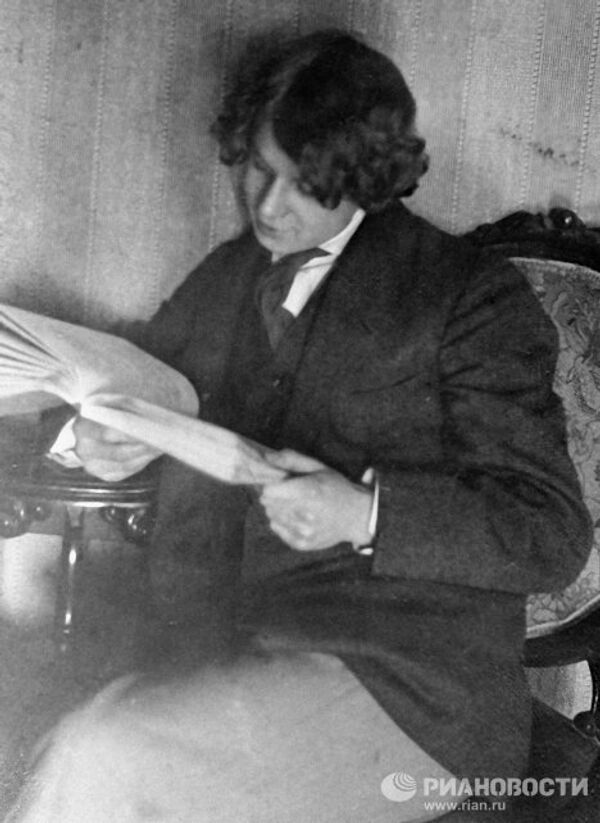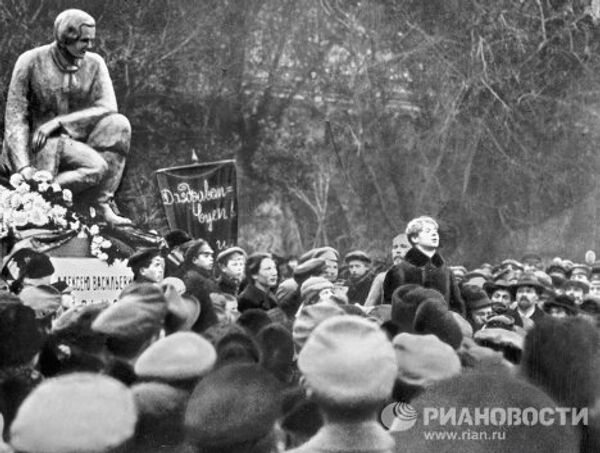October 3 was the 115th anniversary of the birth of Russian poet Sergei Yesenin. His contemporaries often called him the “last poet of the countryside,” but he himself rejected labels, saying “I am just a poet.”

October 3 was the 115th anniversary of the birth of Russian poet Sergei Yesenin. His contemporaries often called him the “last poet of the countryside,” but he himself rejected labels, saying “I am just a poet.”

Yesenin began writing poetry as a child. He moved to Moscow in 1912 after graduating from a church pedagogical school in his native village, which qualified him to teach in literacy schools. Photo: Sergei Yesenin (third from right) with his fellow villagers, 1909.

In 1914, Yesenin published his first poem, “The Birch Tree.” He moved to St. Petersburg in 1915. Photo: Sergei Yesenin, 1915.

During this period, Yesenin recited poetry at literary soirees with fellow poet Nikolai Kluyev to the accompaniment of an accordion and wearing traditional Russian attire: red saffian leather boots and a blue silk shirt tied with a golden belt cord. Photo: poets Sergei Yesenin (left) and Nikolai Klyuyev, 1916.

In late 1918, Yesenin met the poet Anatoly Marienhof. They became close friends. Another poet of Russia’s imaginist school, Matvey Roizman, wrote that the men were like two brothers. Photo: Poets Anatoly Marienhof and Sergei Yesenin, 1920.

In 1917, Yesenin married actress Zinaida Raikh. They got married in a small country church in the Vologda region on their way to the White Sea. The two got divorced in 1921. Raikh later married stage director Vsevolod Meyerhold. Photo: Actress Zinaida Raikh.

In 1921, Yesenin met Isadora Duncan, who was 17 years his senior. They bonded very quickly, and were married in May 1922. The marriage fell apart in 1923. Photo: Sergei Yesenin with dancer Isadora Duncan, 1922.

Yesenin’s third wife, Sofia, was the granddaughter of Leo Tolstoy. They were married in 1925. Shortly before the wedding, Yesenin broke things off once again with his literary secretary Galina Benislavskaya, who had been in love with Yesenin for years. Photo: Yesenin’s sisters Alexandra (sitting) and Yekaterina with her husband, Vasily Nasedkin, publisher Alexander Sakharov, Sergei Yesenin and his wife, Sofia Tolstaya, 1925.

Yesenin criticized the Soviet government in his poem “Land of Scoundrels,” one of his last works, which triggered a state-orchestrated campaign against him. In 1925, he was forced to commit himself to an insane asylum for fear of arrest. Photo: Sergei Yesenin speaking at a ceremony for the unveiling of a stutue of Alexei Koltsov near the Kitai-Gorod Wall in Moscow, 1925.

On December 23, 1925, Yesenin escaped from the asylum with a group of visitors and fled to Leningrad. Five days later, on December 28, he was found dead, having hung himself from the heating pipe in his room in the Angleterre Hotel. Photo: Room No. 5 at the Angleterre Hotel where Sergei Yesenin committed suicide.

Sergei Yesenin was buried on December 31, 1925 in Moscow's Vagankovskoye Cemetery. A year after his death, his former lover Galina Benislavskaya committed suicide at his grave. Isadora Duncan was killed in a tragic accident a year and a half after Yesenin’s death. Photo: Funeral of Sergei Yesenin.

